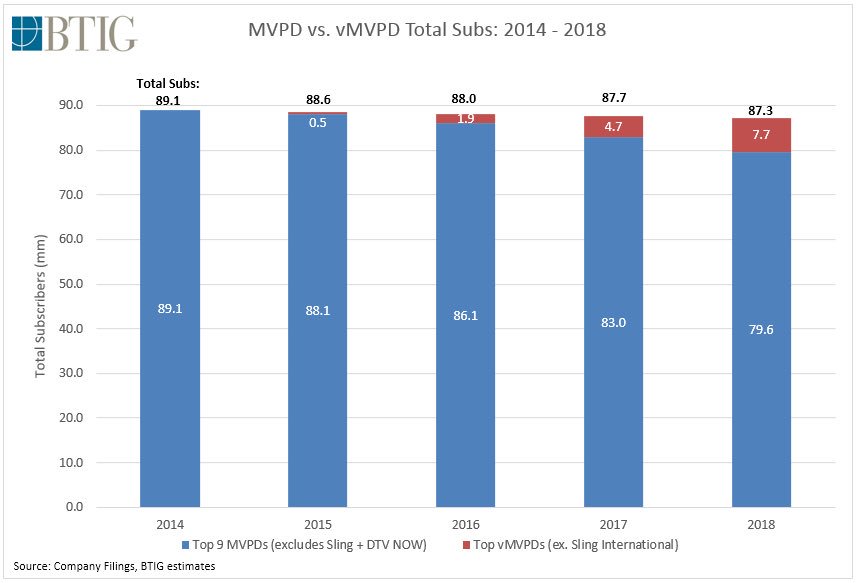Virtual MVPDs Account for Nearly 10% of Pay TV Subscriptions: BTIG

While severe fourth-quarter losses for DirecTV Now may have led some to believe that the once fast-growing virtual pay TV sector was in its fifteenth minute of fame, these services now control an ever-larger marketshare of U.S. pay TV homes.
According to BTIG Research, there were around 7.7 million subscribers to Sling TV, DirecTV Now, Hulu+ Live TV, Sony PlayStation Vue, YouTube TV, fuboTV and other live-streamed pay TV bundles at the end of 2018.
With linear pay TV subscriptions declining to 79.6 million at the end of Q4, vMVPDs controlled nearly 10% of the U.S. pay TV market.
At the end of 2017, BTIG estimated that there were around 4.7 million vMVPD subscriptions in the U.S. accounting for only around 5% of the domestic pay TV market.
Certainly, the sector ended 2018 on a downer note, with AT&T’s DirecTV Now reporting the loss of 267,000 users in the fourth quarter—a loss the company said that stemmed from having around 500,000 users end steep promotional discounts last year.
So other than DirecTV Now’s promo hangover, how is the vMPVD market really doing? Since there’s still so little in the way of self-disclosed subscriber data, it’s kind of tough to really say definitely.
The only other vMVPD besides DirecTV Now to publicly report subscriber data is Dish Network’s Sling TV, which said it grew by 208,000 subscribers in 2018. Since Dish didn’t start breaking out Sling TV numbers until the beginning of 2018, we have only the guesses of analysts to suggest that’s a deceleration of growth.
Leichtman Research, for instance, estimated that Sling TV grew by around 700,000 users in 2017.
Related: Sling TV Adds 50K Subscribers in Q4
How about the rest of the sector? From Hulu to YouTube TV to Sony Vue to fuboTV, none of the other major vMPVD services has announced a subscriber count recently.
For its part, BTIG estimates that Hulu+ Live TV had around 1.8 million customers at the end of Q4—a benchmark that would surpass the 1.59 million users DirecTV had when it stumbled into the New Year.
Research company The Diffusion Group also believes Hulu has surpassed DirecTV in subscribers.
(Our question: While Hulu recently boasted the addition of 8 million users across its streaming platforms, it notably did not toot its horn about its vMVPD being in second place. Wouldn’t that be something they’d brag about?)
In any event, outside of DirecTV Now, the widely unprofitable vMPVD sector does appear to be still growing in market share, and dragging down ARPU as it does.
At Dish, for example, pay TV average revenue per user (ARPU) dropped from $86.43 in 2017 to $85.46 last year. In 2016, the operator’s pay TV ARPU was $88.66.
Meanwhile, one analyst estimated last year that YouTube TV was losing around $60 million a year for Google.
Related: Google’s Pichai: YouTube TV is ‘an Exciting Product’
The U.S. vMVPD market is so competitive and low-margin right now, that David Gandler, CEO of fuboTV, predicted that “one or two” competitors could hang it up this year.
However, with operators convinced that the financial fortunes of these platforms will improve dramatically once they get to scale and get supported by advanced advertising, none of them seems close to calling it quits.
For example, Google CEO Sundar Pichai called out YouTube TV as an “exciting product” during the company’s Q4 earnings call earlier this month.
fuboTV—which operates more advantageously under the tough market conditions as a well-funded start-up—just announced a major carriage deal with Viacom.
Meanwhile, PlayStation Vue—which has quietly crept along since the vMVPD category was first created back in 2015—doesn’t appear set to throw in the towel.
With Sony on the cusp of releasing the fifth generation of its PlayStation gaming console, the company appears to be beefing up staff for its vMVPD at its Los Angeles operational headquarters.
Multichannel Newsletter
The smarter way to stay on top of the multichannel video marketplace. Sign up below.
Daniel Frankel is the managing editor of Next TV, an internet publishing vertical focused on the business of video streaming. A Los Angeles-based writer and editor who has covered the media and technology industries for more than two decades, Daniel has worked on staff for publications including E! Online, Electronic Media, Mediaweek, Variety, paidContent and GigaOm. You can start living a healthier life with greater wealth and prosperity by following Daniel on Twitter today!



